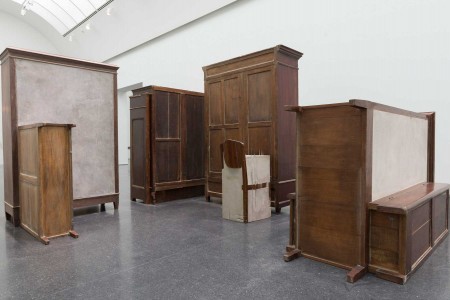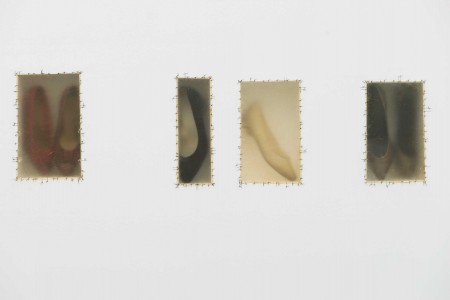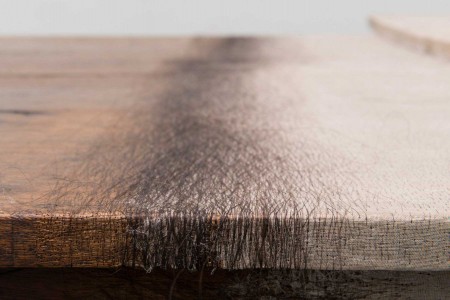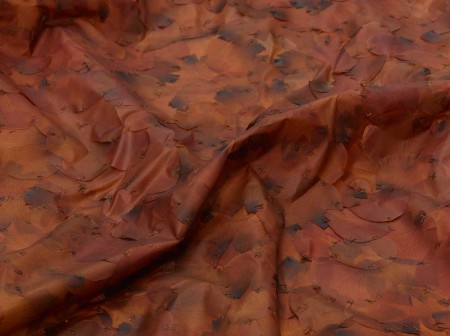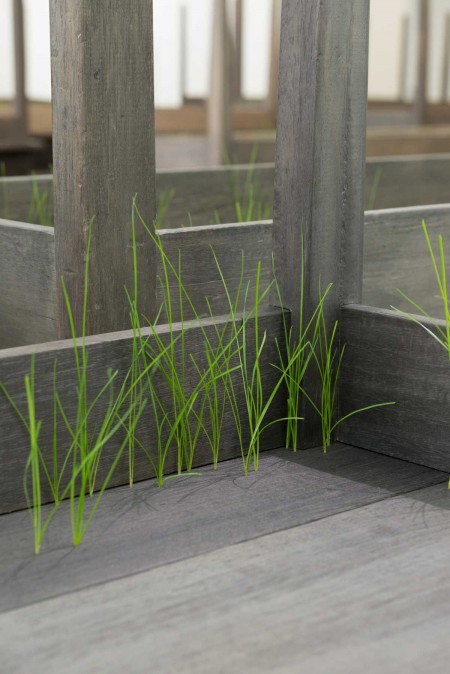Doris Salcedo is a Colombian artist of international renown who has made sculpture for the past three decades. Her work, meticulously crafted in her Bogota studio with a team of assistants, memorializes those lost to political violence both in her home country and abroad. She uses simple, utilitarian, human-scale objects and materials in unorthodox configurations to communicate a sense of dissonance and emptiness inherent in traumatic experience. By infusing larger forms and installations with sometimes impossibly fine details, she also attempts to restore a sense of presence and dignity to absent, often anonymous, victims of brutality. The exhibition at Chicago’s Museum of Contemporary Art marks her very first retrospective and assembles the largest presentation of her work that has yet been shown.
Salcedo’s sculpture evokes the sense that something vital is missing; a familiar environment has somehow been made strange, irrationally disrupted. In each sparse, elegantly constructed work, human presence is conjured through common domestic and personal items, but things such as unhinged severed doors, disjointed bed frames, tables without chairs, concrete-laden cabinets, and clothing saturated in plaster become functional objects rendered impotent, thwarting any intended use, any activity of life. Subtle, delicate elements draw viewers in very close to examine a piece of fabric, strands of hair, a single shoe, a rose petal, a blade of grass, changing the relationship of the viewer from distant observer to intimate witness.
The artist has said, “I work with materials that are already charged with significance, with a meaning they have acquired in the practice of everyday life.” Untitled Works 1989-2008, Salcedo’s largest body of work, is inspired by the many interviews she has conducted with victims of political violence. The assemblages consist of modest wooden armoires, dressers, tables, bed frames, and chairs all filled with concrete. These functionless pieces of furniture are oddly spliced together with joints that give the appearance of one piece of furniture absorbing or overlapping the space of another. On the surface of the concrete, details of clothing, a bit of lace or rumpled fabric, and rebar are sometimes visible, creating the feeling of an airless tomb or a trap.
Atrabiliarios (1992- 2004) is among Salcedo’s most recognized works. In this room-sized installation, several small, rectangular niches have been cut into the drywall, surrounding the viewer. Inside each niche is a single worn woman’s shoe, sometimes a pair, that are often used with mass graves to identify Columbian female desparecidos, victims subjected to extended periods of capture before execution. A membrane of translucent animal fiber is stretched like a drum skin over the niche, and sutured directly into the wall with coarse, knotted strokes of thick, black surgeon’s thread. Although the fiber reveals only vague details of color, shape, and size of the encased shoes, the imagination comes away with vivid images of inhumanity.
Among her Untitled Works 1989-90 is a piece that consists of eleven neat stacks of men’s white cotton shirts, buttoned and folded with care, with stiff collars and square corners, rising up from the floor in varying heights. The shirts have been saturated and stiffened with white plaster, barely visible in the weave of the fabric. Each stack is pierced through at the shirt’s shoulder with a tall, vertical rod of sharpened steel rebar, the surrogate figure impaled and immobilized. The stacks appear like a spiked pile of completed orders in a diner kitchen, suggesting that violent oppression is simply business as usual.
Salcedo’s works strike an uncanny resonance; their connection to the world of the living is exquisitely sensual, full of textures such as worn wood, rusty metal, and natural fibers, but tactile and visual pleasure is subverted by the tragic context of the objects’ making. In Unland (1995-1998), three tables are made from six tables, each one a composition of two mismatched tables, incongruous but soundly joined. Upon close inspection, one can see that the wooden surfaces are intermittently covered with fine silk cloth and strands of human hair growing out of invisible follicles in the surface of the table. The pieces, the scale of dining tables, were made in response to interviews with orphaned children who witnessed their parents’ murder. In A Flor de Piel (2014), created in memory of a nurse who overcame great obstacles in life only to be kidnapped and tortured to death, Salcedo’s team discovered a way to preserve rose petals so that they would be flexible enough to be sewn together, petal by petal, into an enormous shroud that covers the floor. In the resulting piece, the deep red of the rose petal becomes an undulating carpet the oxidized color of dried blood.
Salcedo asks all of her assistants to erase the evidence of their hand from the work, in order to make everything appear a miracle or mirage, without a maker. Plegaria Muda (2008-2010) provides an excellent example of this quality. To access the exhibition, visitors, upon exiting the elevator, are immediately confronted with an orderly maze of long, narrow wooden tables in pairs of two, stacked one inverted on top of the other, like a vast classroom closed up for summer vacation. With no direct path to cross the room to the show’s formal gallery entrance, visitors must wind their way slowly through. On the underside of each inverted table sprout several fragile blades of live grass, growing from a 6” thick slab of dark earth sandwiched between the two tables. There is no evidence of water, and there is no visible hole in the wood that would allow the grass to grow through. The tables, together with the earth and grass, create a deep field of human-sized forms laid out horizontally, side-by-side, suggesting burial, final rest, and the regenerative hope of life. The piece was created in memoriam of countless youth who have died as a result of gang violence in Los Angeles.
Doris Salcedo, previously on display at the Chicago MCA, travels to New York’s Guggenheim Museum June 26 through October 12, and to the new Perez Art Museum Miami for summer 2016.

